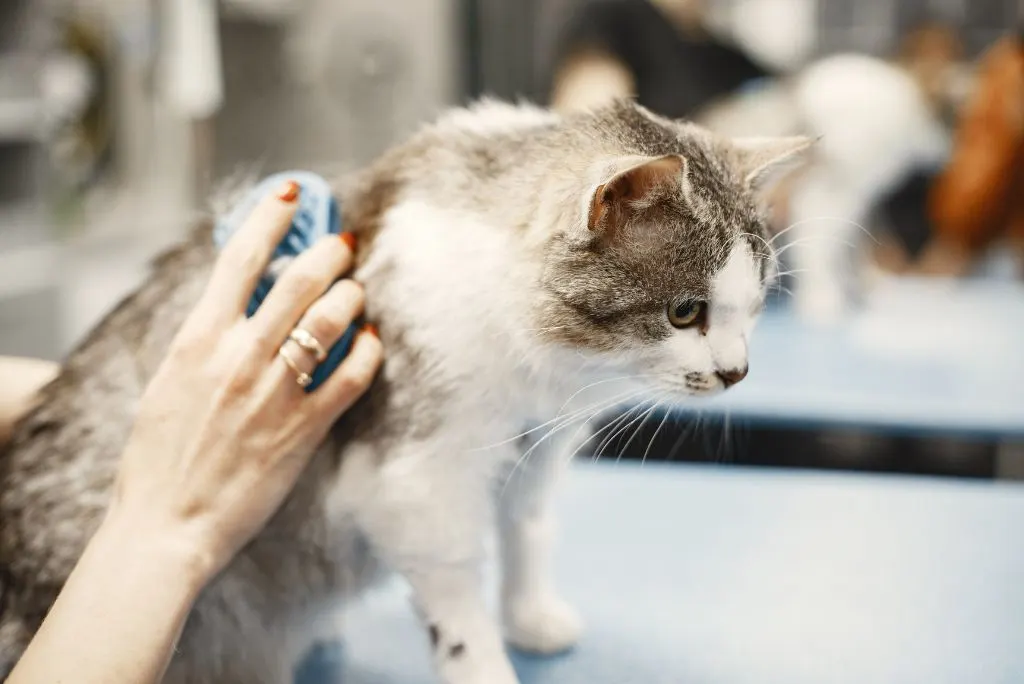Humans are no stranger to skin conditions and allergies. We know how uncomfortable and frustrating the itching and soreness of skin irritations can be…
Now imagine that but with a layer of thick fur on top!
Like us, our kitties can also suffer from cat dermatitis and skin irritations. Which can leave them in great discomfort and distress.
As pet owners it is our job to know the signs of cat dermatitis. And to treat the signs and symptoms before they become too severe.
We’ve put together this handy guide with all the need-to-knows about cat dermatitis signs and symptoms, as well as treatment at home options to keep your fur baby happy and healthy.
Key Takeaways of Cat Dermatitis: Treatment at Home
- Cat dermatitis manifests as uncomfortable itching and soreness of the skin
- It can be caused be a number of factors, including: allergies, aspects of a cat’s environment, common feline ailments like fleas and ticks, and also underlying health conditions
- Knowing the signs and symptoms of cat dermatitis and skin irritations in cats can help with proactive treatment. These symptoms include: itching, head shaking, sores/scabs, rashes/bumps/bites, changes in skin color/texture, hair loss/dandruff, any other usual behaviors
- Treatment at home – you can help soothe your cat’s dermatitis symptoms and keep them comfortable and happy by seeking advice from your vet, keeping on top of your kitty’s cleanliness, using preventative measures & using natural treatments
So, let’s get into it!
What is Cat Dermatitis?
Dermatitis is a condition which, when present in felines, manifests as an uncomfortable itching or soreness of the skin, and is most often triggered by external stimuli.
If left untreated, these conditions can become secondary bacterial infections, and so it is vital to address these issues as soon as they appear.
There are several reasons why your cat may be experiencing skin discomfort or irritation, including:
- Allergies
Just like humans, cats can experience allergic reactions to certain stimuli.
Whether this is plants they come into contact with, bugs and parasites, certain creams, lotions, shampoos and other cat products, specific foodstuffs, your cat can present with an uncomfortable dermal allergy reaction.
- A cat’s environment
Certain environmental elements or changes can provoke dermal reactions in cats, such as different plants and flowers in the home or garden and washing powders or cleaning products.
If your cat does react to something in the home, it’s important to take note and remove it as soon as possible to avoid further reactions.
- Common feline ailments
Any cat owner will know that cats are prone to conditions such as fleas and ticks, as well as the more infectious (to both cats and humans) ringworm.
And so it’s vital to check whether these unwanted visitors are the cause of your cat’s discomfort, so that this can be treated accordingly and efficiently.
Always consult with your vet about appropriate parasitic treatments, as well as full and correct tick removal to avoid further irritations or infections.
Preventative parasitic measures are super important when it comes to keeping your kitty bug-free and squeaky clean. So keeping on top of regular treatments will reduce the risk of critter infestations.
Infectious dermatitis (e.g. ringworm, fungal and yeast infections) should be handled with particular caution, in order to stop them spreading amongst other animals and humans.
- Underlying conditions
Your cat’s dermatitis may be the result of an underlying health condition, and so it is always important to consult with your vet if you notice dermal symptoms or reactions present in your cat.
This will help to rule out any more sinister causes.

Cat Dermatitis: Symptoms and What to Look For
Luckily, dermatitis offers a good visual indication as to whether your cat requires treatment for certain dermal issues.
(Plus your cat will surely let you know if they aren’t happy!)
Some of these symptoms include:
- Itching and head shaking
Itching is one of the most telling behaviors that your cat is suffering with skin issues. If you see that your cat is itching or grooming themselves more than usual, be sure to check their skin and fur for any physical signs of irritation or debris.
The more your cat scratches, the more likely they are to break the skin and let infection in. So it’s important to recognize and intercept these behaviors quickly.
- Sores and scabs
Sores and scabbing/crusting are a tell-tale sign of irritation, and are a sign that the skin is or has been broken.
This may mean that infection can or has already gotten under the skin. And so a visit to the vet is a must when you notice scabbing or lesions on your cat’s skin.
- Rashes, bumps and bites
Rashes, bumps and bites are a great indication of allergies or possible parasitic afflictions such as fleas.
If you notice these marks on your cat’s skin, it’s an obvious sign that treatment is needed. This will mean either using antihistamines or other hypoallergenic products, or further parasitic and bug treatments.
Get your cat booked in to see the vet and give those nasty parasites their eviction notice – your cat’s fur is for snuggling, not inhabiting!
- Changes in skin color and texture
You may notice redness in areas of your cat’s skin, or parts that have become darker in color.
There may also be a change in texture, perhaps a thickening or roughening of certain areas.
These symptoms can all be an indication that your cat is suffering with dermatological irritation, and that they may require further treatment.
Also Read: How to Treat Cat Chin Acne
- Hair loss and dandruff
Another indicator of dermatitis is hair loss or the production of dandruff, showing that the skin is not in the condition it should be and needs treatment.
- Other unusual behaviors
If skin irritation is paired with unusual behaviors in your cat (e.g. vomiting and diarrhea, coughing and breathing difficulties, lethargy, paralysis) it is vital to get your little buddy to the vet ASAP.
The key to recovery is catching things quickly, so keep an eye on your fur-baby and seek help or advice from a medical professional if you are at all concerned.

Treating Cat Dermatitis at Home
There are a variety of at-home treatments for cat dermatitis which can be used to soothe and eradicate your kitty’s symptoms. Helping them to get them back to their curious, cuddly selves.
Why not try:
- Vet-approved treatments
Your number one action when dealing with cat dermatitis should be a visit to the vet.
A trip to the vet will ensure a proper diagnosis and advice on the most safe and effective forms of treatment to soothe and eradicate skin issues.
It will also ensure that there is nothing left untreated, which could cause more extensive damage or discomfort for your furry friend.
Veterinarians will be able to expertly recognize the signs and symptoms of various skin issues and disorders. And can therefore prescribe and advise on the appropriate treatments, creams and ointments to best help your cat.
They will also know whether your cat will need further tests or medicines. Especially if they suspect there may be an underlying health issue to your cat’s dermatological symptoms.
They’re kind of like animal superheroes!
- Keeping your kitty clean
This one may sound obvious, but it’s also an easy one to overlook.
One of the most important things to help prevent further infection or irritation is to maintain your cat’s cleanliness. Particularly the areas where their skin has been affected.
Dirt getting into open sores or cracks in the skin is a one way ticket to infection. And so making sure to regularly clean your cat’s wounds and other affected areas is super vital in aiding the healing process.

- Preventative measures
As they say, the best offense is a good defense!
Keeping up to date with your cat’s flea and worm treatments is one of the best ways to keep your kitty as healthy as possible. Plus, also ensuring that your cat’s food and environment don’t provoke allergic reactions.
Of course, we cannot protect our fur babies from every little thing that comes their way. But we can create a safe and solid environment in which they can thrive.
(You may want to try a cat flea and tick collar. But make sure to consult with your vet on this first.)
- Natural ways to help soothe your cat’s symptoms
Vet-approved medicines will be the key to eradicating more serious conditions. But using natural products can be a wonderful way to soothe your cat’s symptoms and keep them more comfortable.
Some of these include regular brushing to maintain an even distribution of natural skin oils. And the removal of excess hair and dry skin.
Also, you can consider oatmeal baths to soothe itching and irritation (take a look at this cat oatmeal shampoo). Or other natural pet products for use on irritated skin (such as this skin care lotion for cats or these salmon natural cat treats).

Cat Dermatitis: The Wrap-Up
Phew! Now we know that was probably a lot to take in. However it is all ultra important in keeping your sweet kitty cat happy and healthy.
To condense it down into a neat little package for you to take away:
- Cat dermatitis can occur for a multitude of reasons. Such as: allergies to food or products, as well as reactions to environmental stimuli such as plants or products. Dermal reactions can also be caused by parasites, fungal, yeast and bacterial infections. As well as being an indicator of possible underlying health conditions.
Catching it quickly is the key to recovery! Noticing symptoms and intercepting them quickly is the best way to ensure an efficient recovery for your cat.
- Look out for: itching, redness, sores and scabbing, crusting, dandruff, hair loss, changes in skin color/texture.
And be particularly vigilant if any of these skin issues are paired with more serious or unusual behaviors. For example: vomiting and diarrhea, coughing and breathing difficulties, lethargy, paralysis, etc.
- Consult your vet for professional advice on treatments for your cat’s dermatitis. Additionally, proper hygiene and maintenance of your cat staves off infection.
Also, natural remedies such as soothing oatmeal baths can help keep your cat comfortable while they recover.
And there we have it!
We hope this has been a helpful introductory insight into knowing the signs and symptoms of cat dermatitis. And how to go about finding the best treatment options for your kitty.
Our advice would be to ALWAYS consult your vet if you notice anything unusual in your cat’s symptoms or behavior. Just to make sure you have got a professional’s eyes on your well-loved little one.
We love hearing from you and would be interested to know about your experiences with cat dermatitis and skin issues. Let’s share the knowledge with fellow pet parents!
And make sure to check out our other articles on cat wellness too. You may just discover something new!

Louise
Sunday 18th of December 2022
what can i do regarding my cat who is urinating a little blood in weeing lately